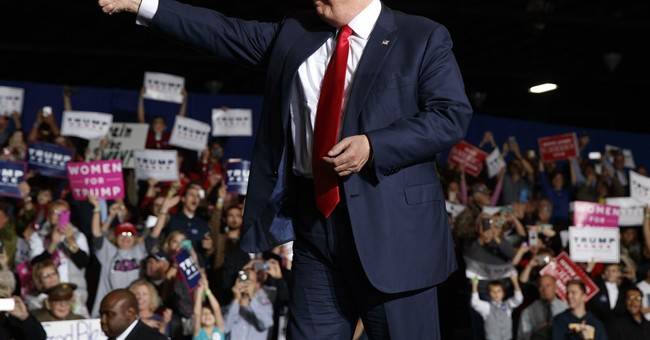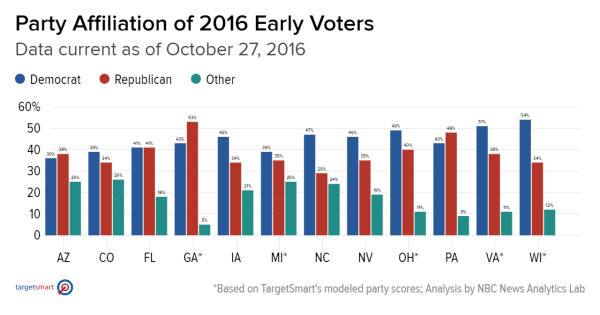Vigilante
Diamond Member
- Banned
- #1
I'm sure the spin of the left will be right along!
Townhall.com ^ | October 28, 2016 | Frank Cannon

Editor's Note: This piece was co-authored by Jon Schweppe.
"It's over. Trump can't win." That's the narrative the Clinton campaign and the mainstream media have relentlessly promoted over the past several days. The problem with that narrative is that it is a bald-faced lie. This election is nowhere near over. Not even close!
Let's take a look at the electoral map. Remember, to become the next president of the United States, Trump needs to win 270 electoral votes. Conversely, he needs to hold Hillary Clinton to 269 electoral votes because, with a Republican House of Representatives, a 269-269 tie is likely to also result in a Trump presidency.
Trump's baseline amount of electoral votes is 158. Let's assume Clinton's baseline is 239 — we will generously cede her Virginia (13), Minnesota (10), Wisconsin (10), Michigan (16), New Mexico (5), and three of Maine's four electoral votes.
If this is a fixed reality, Trump must win the following states to get to 265 electoral votes (ordered from easiest to win to most difficult):
Utah
Georgia
Iowa
Ohio
The five most recent polls out of Ohio show Trump tied with Clinton or leading. He has performed well here since the end of August. While the race is still very close, Trump's working class appeal is likely to help him win a blue collar state that Mitt Romney could not.
Arizona
Florida
Nevada
North Carolina
If Trump can pull all of this off, that would get him to 265 electoral votes. He is within three points in each of the states just mentioned.
Then we have three states (and a district) remaining:
Pennsylvania
Colorado
New Hampshire and Maine's 2nd Congressional District
As you can see, even if we accept the conventional wisdom that polls are always correct — they aren’t — and that pollsters completely understand how the 2016 electorate will shake out — they don't — during an election that every self-proclaimed pundit and political professional has gotten wrong from the very beginning, Trump still has a very reasonable, though difficult, path to victory. Even in this scenario, one would have to assume he has a 20 percent or greater chance to win on November 8.
But what if we challenge some assumptions?
Imagine that these polling turnout models are oversampling Democrats by a couple percentage points, overestimating turnout for Hillary Clinton and plugging in numbers that would even exceed President Obama's historic turnout in 2008 and 2012 — and when you investigate the cross-tabs on some of these polls, you absolutely see evidence of this taking place.
What if the polls are getting it wrong, even slightly?
And what if there is a true Bradley Effect taking place with Donald Trump that is impacting polling results, i.e. a statistically significant number of Trump voters who are afraid to publicly announce, even to an anonymous pollster over the phone, that they are Trump voters in fear of social backlash, especially following the aggressive attempts by the radical left to intimidate and silence Trump voters by using charged language and even by threatening violence? Are we really sure this is an impossibility?
These factors combined could be worth two to four percentage points. Maybe more.
Suddenly, Trump could very well have the 265 electoral votes locked down and be within striking distance in Pennsylvania, Colorado, New Hampshire, and Maine’s 2nd Congressional District, needing to win just one more state to become president.
We aren’t saying the polls are wrong. They very well might be correct. But the point stands — even if the polls are 100 percent correct, Trump is still a stone’s throw away from winning this election. And if they’re wrong? If there are faulty assumptions in the turnout models that are inadvertently discounting Trump support? Well, then we should be having an entirely different conversation.
The conventional wisdom says Trump is done. We’d bet against
Townhall.com ^ | October 28, 2016 | Frank Cannon

Editor's Note: This piece was co-authored by Jon Schweppe.
"It's over. Trump can't win." That's the narrative the Clinton campaign and the mainstream media have relentlessly promoted over the past several days. The problem with that narrative is that it is a bald-faced lie. This election is nowhere near over. Not even close!
Let's take a look at the electoral map. Remember, to become the next president of the United States, Trump needs to win 270 electoral votes. Conversely, he needs to hold Hillary Clinton to 269 electoral votes because, with a Republican House of Representatives, a 269-269 tie is likely to also result in a Trump presidency.
Trump's baseline amount of electoral votes is 158. Let's assume Clinton's baseline is 239 — we will generously cede her Virginia (13), Minnesota (10), Wisconsin (10), Michigan (16), New Mexico (5), and three of Maine's four electoral votes.
If this is a fixed reality, Trump must win the following states to get to 265 electoral votes (ordered from easiest to win to most difficult):
Utah
- Electoral Votes: 6
- RealClearPolitics (RCP) Average: Trump +5.8%
Georgia
- Electoral Votes: 16
- RealClearPolitics (RCP) Average: Trump +2.8%
Iowa
- Electoral Votes: 6
- RealClearPolitics (RCP) Average: Trump +1.4%
Ohio
- Electoral Votes: 18
- RealClearPolitics (RCP) Average: Trump +1.1%
The five most recent polls out of Ohio show Trump tied with Clinton or leading. He has performed well here since the end of August. While the race is still very close, Trump's working class appeal is likely to help him win a blue collar state that Mitt Romney could not.
Arizona
- Electoral Votes: 11
- RealClearPolitics (RCP) Average: Trump -1.5%
Florida
- Electoral Votes: 29
- RealClearPolitics (RCP) Average: Trump -1.6%
Nevada
- Electoral Votes: 6
- RealClearPolitics (RCP) Average: Trump -2.0%
North Carolina
- Electoral Votes: 15
- RealClearPolitics (RCP) Average: Trump -2.4%
If Trump can pull all of this off, that would get him to 265 electoral votes. He is within three points in each of the states just mentioned.
Then we have three states (and a district) remaining:
Pennsylvania
- Electoral Votes: 20
- RealClearPolitics (RCP) Average: Trump -5.0%
Colorado
- Electoral Votes: 9
- RealClearPolitics (RCP) Average: Trump -6.2%
New Hampshire and Maine's 2nd Congressional District
- Electoral Votes: 4 + 1
- RealClearPolitics (RCP) Average (NH): Trump -6.5%
- RealClearPolitics (RCP) Average (ME-2): Trump +4.7%
As you can see, even if we accept the conventional wisdom that polls are always correct — they aren’t — and that pollsters completely understand how the 2016 electorate will shake out — they don't — during an election that every self-proclaimed pundit and political professional has gotten wrong from the very beginning, Trump still has a very reasonable, though difficult, path to victory. Even in this scenario, one would have to assume he has a 20 percent or greater chance to win on November 8.
But what if we challenge some assumptions?
Imagine that these polling turnout models are oversampling Democrats by a couple percentage points, overestimating turnout for Hillary Clinton and plugging in numbers that would even exceed President Obama's historic turnout in 2008 and 2012 — and when you investigate the cross-tabs on some of these polls, you absolutely see evidence of this taking place.
What if the polls are getting it wrong, even slightly?
And what if there is a true Bradley Effect taking place with Donald Trump that is impacting polling results, i.e. a statistically significant number of Trump voters who are afraid to publicly announce, even to an anonymous pollster over the phone, that they are Trump voters in fear of social backlash, especially following the aggressive attempts by the radical left to intimidate and silence Trump voters by using charged language and even by threatening violence? Are we really sure this is an impossibility?
These factors combined could be worth two to four percentage points. Maybe more.
Suddenly, Trump could very well have the 265 electoral votes locked down and be within striking distance in Pennsylvania, Colorado, New Hampshire, and Maine’s 2nd Congressional District, needing to win just one more state to become president.
We aren’t saying the polls are wrong. They very well might be correct. But the point stands — even if the polls are 100 percent correct, Trump is still a stone’s throw away from winning this election. And if they’re wrong? If there are faulty assumptions in the turnout models that are inadvertently discounting Trump support? Well, then we should be having an entirely different conversation.
The conventional wisdom says Trump is done. We’d bet against
